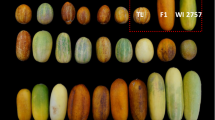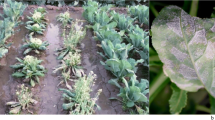Summary
Experiments were conducted in Wisconsin and Michigan to determine whether selection for multiple disease resistance adversely affects yielding ability of commercial cucumber (Cucumis sativus var. sativus L.; CS) lines. Inbred F4 and F5 lines were developed from C. sativus var. hardwickii (R.) Alef. (CH) x CS which had been either selected or not selected for resistance to the causal organisms of scab, anthracnose, and downy mildew. The exotic CH germplasms possesses a multiple fruiting habit with high yield potential and the CS genotypes include several disease resistance. In each comparison between selected and unselected progeny, the unselected families either significantly outyielded, or were not significantly different than their selected counterparts. In no case did the selected progeny outyield the unselected progeny. Since this was observed for both fruit number per plant and total fruit weight per plant, and it occurred despite differences in fruit size, we conclude that selection for disease resistance led to a reduction in yield potential in these populations.
Similar content being viewed by others
References
Abul-HayjaF., P.H.Williams & E.D.P.Whelan, 1975. Independence of scab and bacterial wilt resistance and ten seedling markers in cucumber. HortScience 10: 423–424.
BakerR.J. & W.Bushuk, 1978. Inheritance of differences in gliadin electrophoregrams in the progeny of Neepawa and Pitic 62 wheats. Can. J. Plant Sci. 58: 325–329.
BilssF.A., 1981. Utilization of vegetable germplasm. HortScience 16: 129–132.
BlissF.A., 1982. The inbred backcross line method for improving quantitative traits of self-pollinated plants. Austral. J. Biol. Sci. 21: 70–719.
DavisS.M. & P.L.Crane, 1976. Recurrent selection for rind thickness in maize and its relationship with yield, lodging, and other plant characteristics. Crop Sci. 16: 53–55.
DeveyM.E. & W.A.Russell, 1983. Evaluation of recurrent selection for stalk quality in a maize cultivar and effects on other agronomic traits. Iowa State J. Res. 58: 207–209.
FredrickL.R. & J.E.Staub, 1989. Combining ability analyses of fruit yield and quality in near-homozygous lines derived from cucumber. J. Amer. Soc. Hort. Sci. 114: 332–338.
HorstE.K. & R.L.Lower, 1978. Cucumis hardwickii: A source of germplasm for the cucumber breeder. Cucurbit Gen. Coop. Rpt. 1: 5.
JinahyonS. & W.A.Russell, 1969a. Evaluation of recurrent selection for stalk-rot resistance in an open-pollinated variety of maize. Iowa State J. Sci. 43: 229–237.
JinahyonS. & W.A.Russell, 1969b. Effects of recurrent selection for stalk-rot resistance on other agronomic characters in an open-pollinated variety of maize. Iowa State J. Sci. 43: 239–251.
KlenkeJ.R., W.A.Russell & W.D.Guthrie, 1986. Recurrent selection for resistance to European corn borer in a corn synthetic and correlated effects on agronomic traits. Crop Sci. 26: 859–863.
KupperR.S. & J.E.Staub, 1988. Combining ability between lines of Cucumis sativus L. and Cucumis sativus var. hardwickii (R.) Alef. Euphytica. 38: 197–210.
LeppikE.E., 1966. Relative resistance of Cucumis spp. to diseases and insects. Plant Intr. Investigation Papers. 4: 1–8.
LowerR.L., J.Nienhuis & C.H.Miller, 1982. Gene action and heterosis for yield and vegetative characteristics in a cross between a gynoecious pickling cucumber inbred and a Cucumis sativus var. hardwickii line. J. Amer. Soc. Hort. Sci. 107: 75–78.
OwensK.W., F.A.Bliss & C.E.Peterson, 1985. Genetic analysis of fruit length and weight in two cucumber populations using the inbred backcross line method. J. Amer. Soc. Hort. Sci. 110: 421–436.
MartinM.J. & W.A.Russell, 1984. Correlated responses of yield and other agronomic traits to recurrent selection for stalk quality in a maize synthetic. Crop Sci. 24: 746–750.
StaubJ.E. & R.S.Kupper, 1985. Use of Cucumis sativus var. hardwickii germplasm in backcrosses with Cucumis sativus var. sativus. HortScience 20: 436–438.
StaubJ.E. & C.E.Peterson, 1986. Comparisons between bacterial wilt resistant and susceptible gynoecious cucumber lines and F1 progeny. HortScience 21: 1428–1430.
StaubJ.E., D.Globerson & A.Genizi, 1989. Inheritance of seed dormancy in Cucumis sativus var. hardwickii (Royle) Alef. Ther. Appl. Gen. 78: 143–151.
ThompsonD.L., 1982. Grain yield of two synthetics of corn after seven cycles of selection for lodging resistance. Crop Sci. 22: 1207–1210.
ThurlingN., 1982. The utilization of backcrossing in improving the seed yield of spring rape (Brassica napus L.). Z. Pflanzen Zücht. 88: 43–53.
WehrhahnC. & R.W.Allard, 1979. The detection and measurement of the effects of individual genes involved in the inheritance of quantitative character in wheat. Genetics 51: 109–119.
WiddersI.E. & H.C.Price, 1989. Effects of plant density on growth and biomass partitioning in pickling cucumbers. J. Amer. Soc. Hort. Sci. 114: 751–755.
Author information
Authors and Affiliations
Additional information
Received for publication-. The cost of publishing this paper was defrayed in part by the payment of page charges. Under postal regulations, this paper therefore must be hereby marked advertisement solely to indicate this fact.
Rights and permissions
About this article
Cite this article
Staub, J.E., Grumet, R. Selection for multiple disease resistance reduces cucumber yield potential. Euphytica 67, 205–213 (1993). https://doi.org/10.1007/BF00040622
Received:
Accepted:
Issue Date:
DOI: https://doi.org/10.1007/BF00040622




